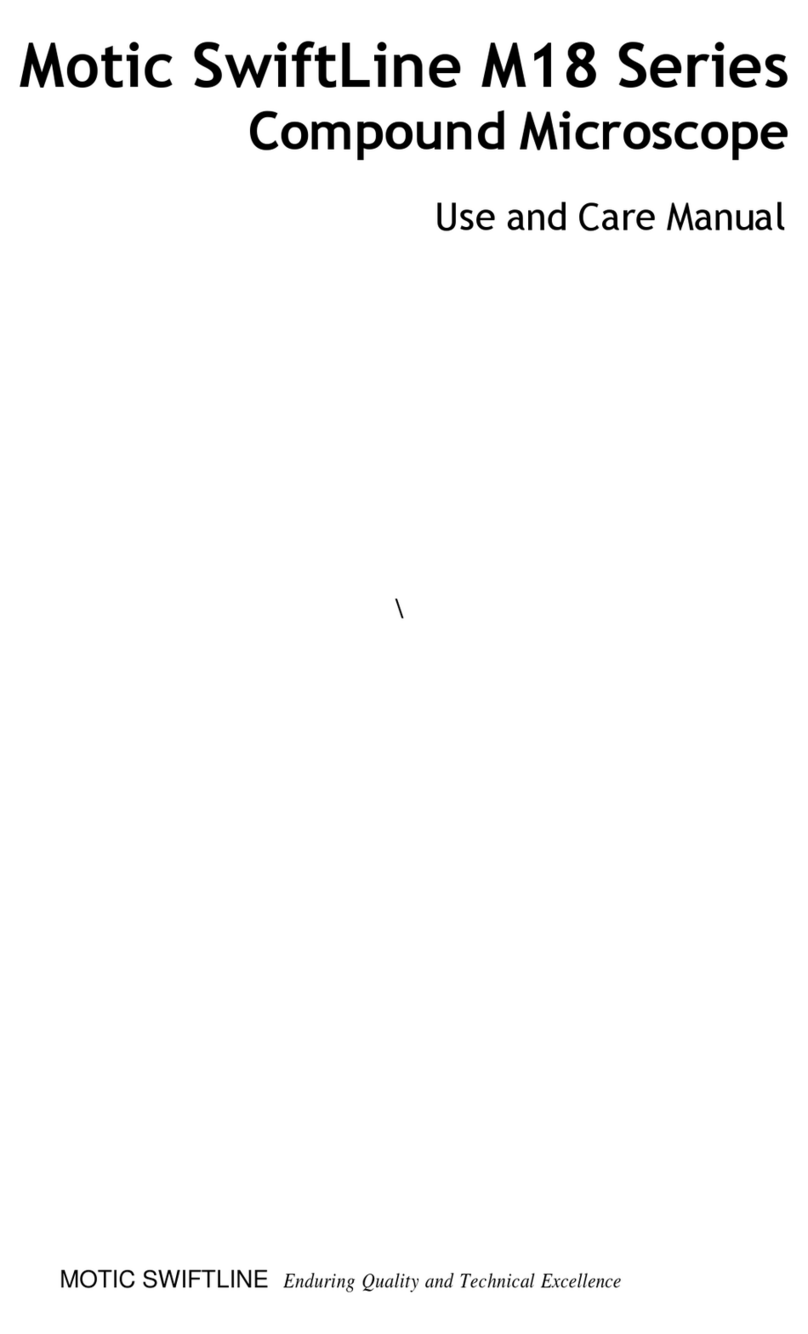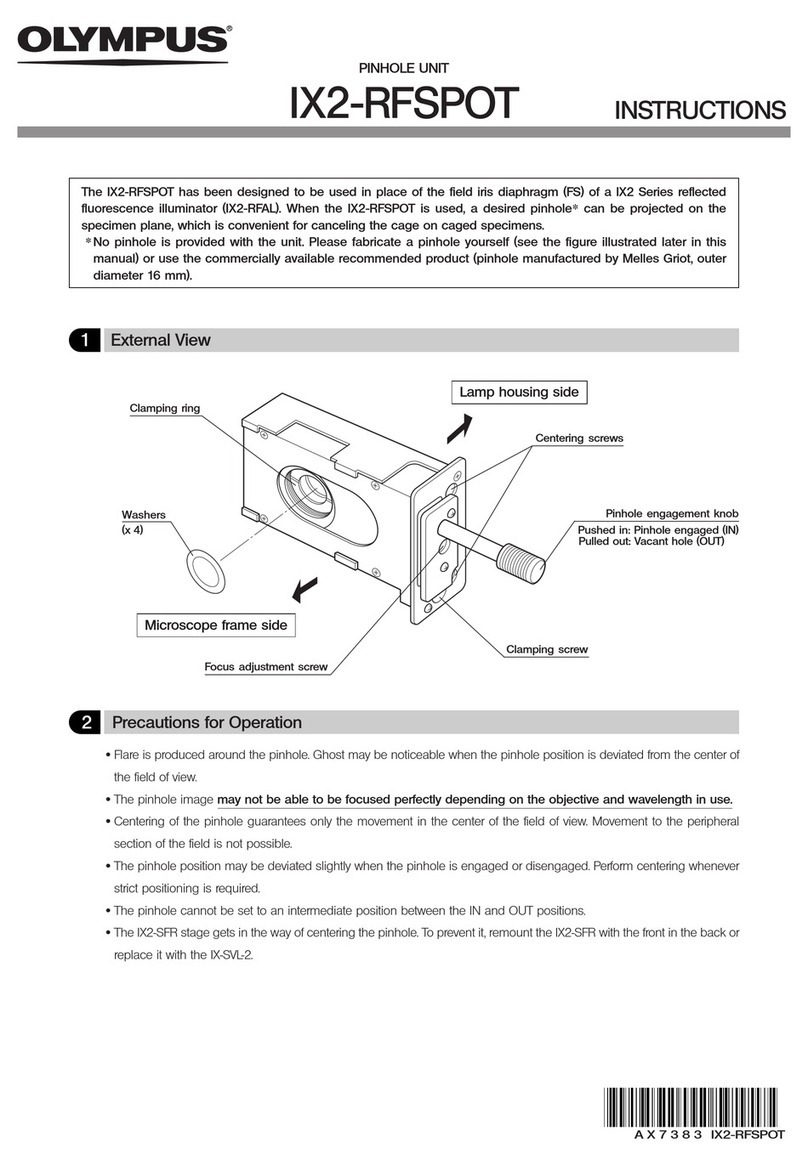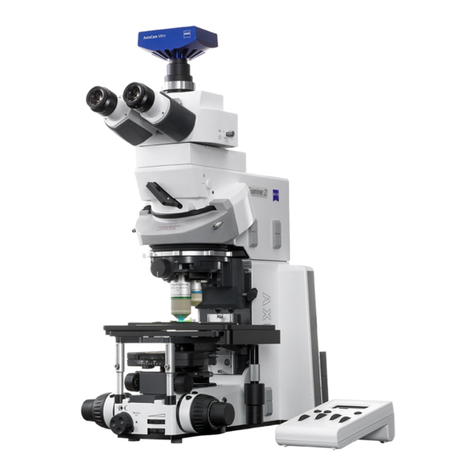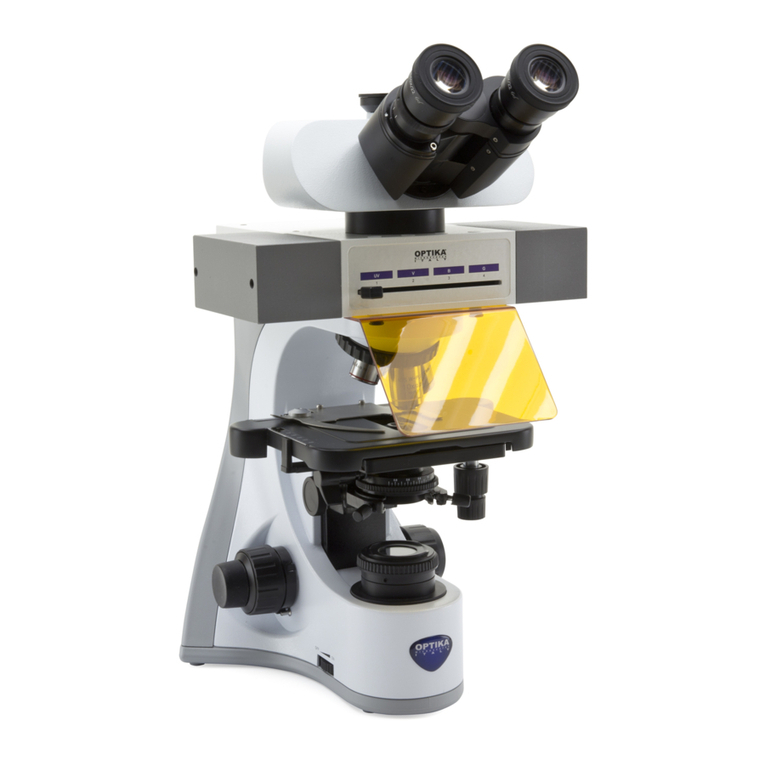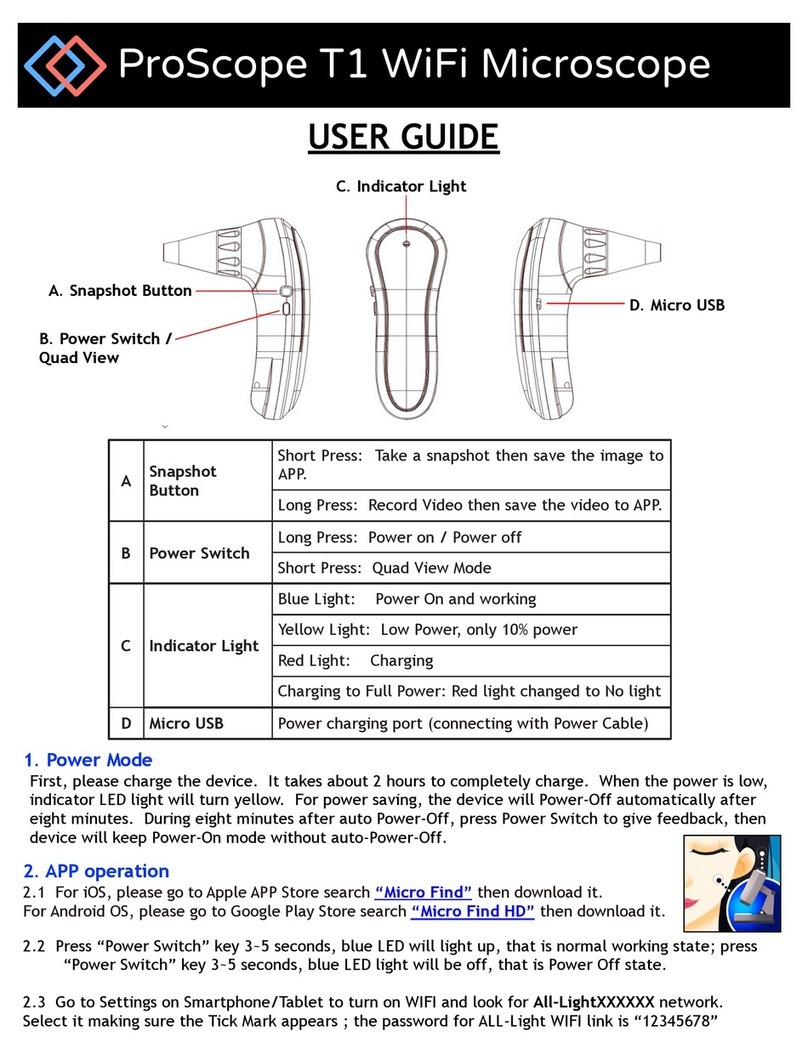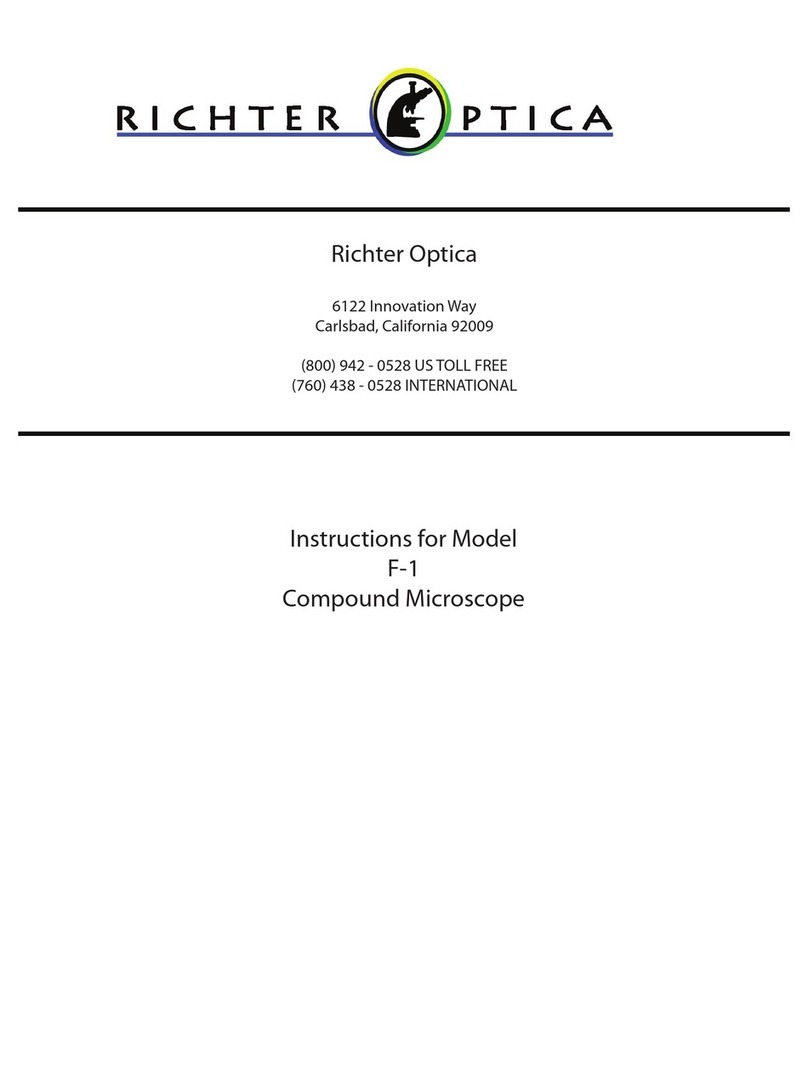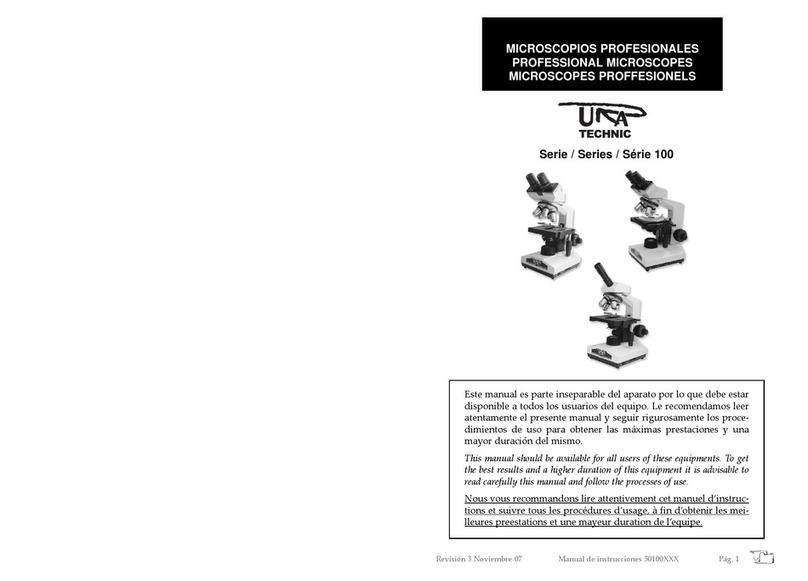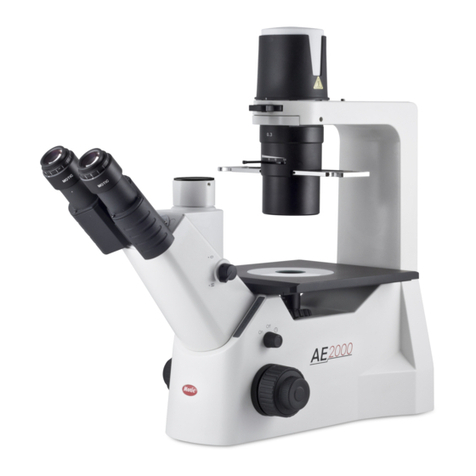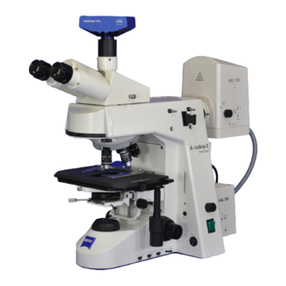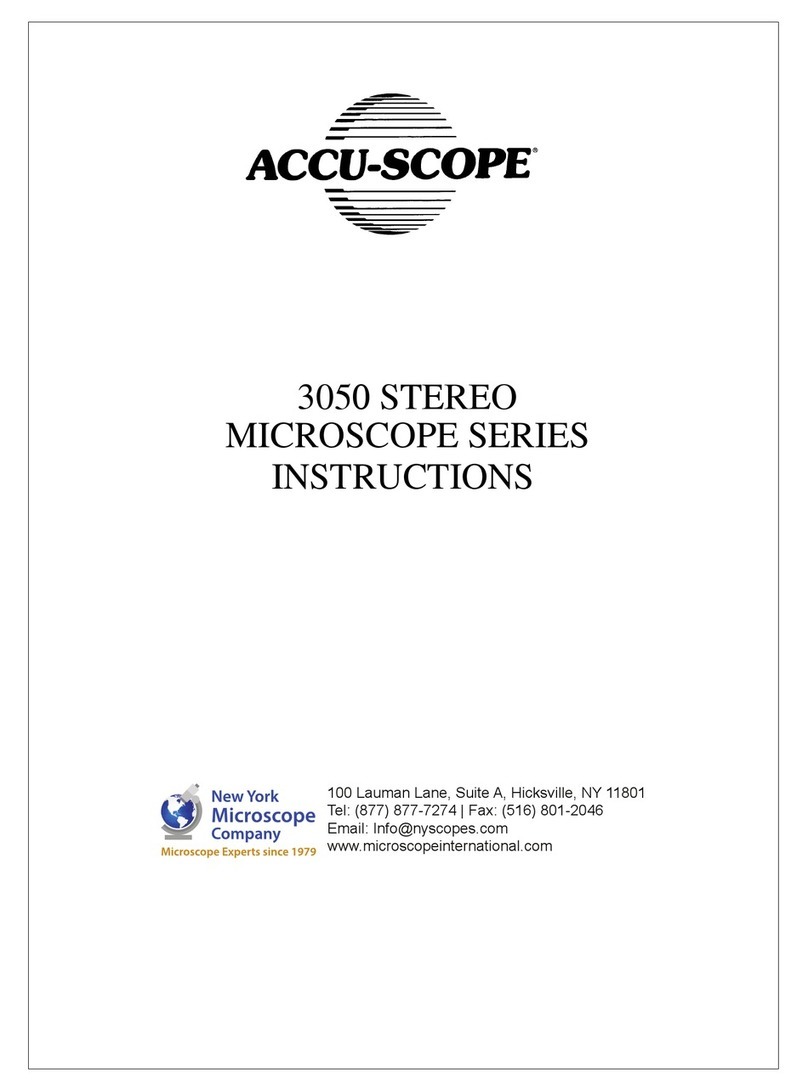insize ISM-M1000 User manual

OPERATION MANUAL
ISM-M1000
Metallurgical Microscope
www.insize.com

Congratulations and Thank You for your purchase of
The Microscope
Getting Started 3
Components 4
Technical Specifications 5
Setup Instructions 5
Basic Operation 6
Changing the Lamp 10
Changing the Fuse 11
Preventative Maintenance 12
PLEASE DISCONNECT PLUG FROM MAINS SOCKET BEFORE REMOVING
THE BOTTOM PLATE, OPENING THE LAMP REPLACEMENT DOOR, OR
REMOVING THE LAMP HOUSE
THE POWER CORD PROVIDED WITH THE EQUIPMENT HAS A GROUNDED
PLUG. ALWAYS USE THE POWER CORD WITH A PROPERLY GROUNDED
WALL OUTLET.
DO NOT EXPOSE THE INSTRUMENT TO HIGH TEMPERATURES OR
HUMIDITY. AVOID USING THE INSTRUMENT IN EXTREMELY DUSTY
LOCATIONS.
OPERATING TEMPERATURE 5°C TO 35°C
OPERATING HUMIDITY: 20% TO 80% @ 25°C
WARNING
WARNING
1 2
Contents
This precision instrument has been designed to require a minimum of
optical and mechanical maintenance. Its excellent design assures years
of high quality, reliable service. We recommend you read this entire
manual carefully before beginning to use the instrument.
CAUTION: NEVER IMMERSE THE INSTRUMENT IN WATER OR SOLVENT
CAUTION: DO NOT PUT ANY FOREIGN OBJECTS IN THE FRAME OR INTO
ANY MOVING MECHANICAL PARTS

12
7
8
9
10
13
14
15
16
17
18
19
20
21
1
2
3
4
6
5
11
28
27
26
24
25
22
23
Figure 1
This guide is written on the assumption that it will be used by advanced
students and experienced microscopists. It covers the essential
adjustments and controls of microscopes. No attempt has been made to
include fundamentals of microscopy. Read this guide prior to unpacking
the microscope. This guide is designed to illustrate a sequential method
for assembly and operation. We recommend the instructions be followed
in a sequential process. After assembling the instrument, re-read the
guide and become familiar with all adjustments and functions before
using your new microscope.
Components
3 4
Getting Started
1.Eyepiece 2.Switch Handspike For Observe/Photograph 3.
Thumbscrew 4.Trinocular 5. Up Stop 6. Table-board Longitudinal
Adjustment Knob 7. Brightness Control Knob 8. Table-board
Transverse Adjustment Knob 9. Power Switch 10. Field Diaphragm
Centering Screw 11. Focusing Lens Adjustment Lever 12. Light Bulb
Vertical Adjustment knob 13. Light Bulb Transverse Adjustment knob
14. Lamp House 15. Filter Wheel 16. Aperture Diaphragm Adjustment
Lever 17. Field Diaphragm Adjustment Lever 18.Objective 19.Stage
20.Stretchy Clip 21.Binocular 22.Polarizer (Optional) 23 Lamp
House Set Screw.24.Focus Tensional Adjustment Knob 25.Coarse
Focus Control Knob 26. Fine Focus Control Knob 27. Power Outlet
with Fuse Seat 28. Power Inlet

Magnification
10X
20X
40X
100X(Spring,Oil)
W.D.(mm)
8.8
8.6
3.73
0.33
N.A.
0.25
0.40
0.60
1.25
Type(no cover glass)
Plan achromatic
Technical Specifications
Trinocular: Inclined 30°.
Objectives:
Nosepiece: Quadruple nosepiece ball-bearing reversed nosepiece with
positive click stops and smooth operation.
Eyepieces: 10X wide field eyepiece, focal length 25mm, fieldØ18mm.
Stage: Double layer mechanical,
Size: 180mmX150mm,
Moving range: 15mmX15mm.
Filters: Ground glass, blue filter, green filter and yellow filter.
Illumination: 6V/20W halogen lamp, adjustable brightness.
Power supply: 220V(50/60HZ) or 110V(50/60HZ).
Anti-fungus: Yes.
Setup Instructions
1. Remove all parts from their packing materials and retain the
packaging in the event you need to transport the product.
2. Connect the power cord to a suitable power supply.
Figure 2
Figure 3
The power switch to the
illuminator and the brightness
control is located on the base.
The electrical system is fuse
protected and the fuse holder
located on the socket.
Turn on the light with the
power switch, see figure 2. If
the light does not appear to
be ON, check the brightness
control to see if it's on a
sufficiently low setting. Then
adjust the brightness control
until image can be observed
comfortably.
Note: Using the light at
brightest setting reduces
life span of lamp.
Foc using adjustment is
accomplished by using the
larg e c oarse a djust m e nt
knobs located comfortably on
each side of the frame. Fine
adjustment is accomplished
usi ng the sm aller knobs
located on the same focus
shaft. This coaxial arrangement
allows for easy, precise
ad ju s t m en t w it h o u t d r i ft
or discomfort.
Basic Operation
1. Illumination controls
1)
2)
2. Focusing Controls
1. Brightness Control Knob
2. Power Switch
1. Focus Tension Adjustment
K nob
2. Up Stop
3. Coarse Focus Control Knob
4. Fine Focus Control Knob
1)
5 6
12
1 2 34

Focus Control Turning either of the coarse focus control knobs
will raise or lower the stage. The smallest graduation on the fine
adjust knob index scale is 2μm of vertical.
Focus Tension Adjustment The tension of the coarse focus is
adjustable and preset at the factory for ease of use. If you wish to
adjust the coarse focus tension, first locate the tension adjustment
ring, It is located between the frame and coarse adjustment knob.
Turning the ring toward the rear of the microscope increases the
tension, and toward the front of the microscope loosens it. Tension
is too high if you experience physical discomfort.
Pre-focusing or Focus Stop Control Use of this feature will
insure that the shorter working distance objectives don't contact
the stage or specimen when using the microscope. Its use also
simplifies focusing. After focusing on the specimen with the coarse
adjustment by low magnification eyepiece, rotation of the lever
toward the handler will set and upper limit on the coarse
adjustment movement. After changing specimens or objectives,
focusing is easily accomplished by rotating the coarse adjustment
knob to reach the pre-focused position, then making fine
adjustments with the fine adjustment knob. Focusing movement
with the fine adjustment isn't affected by using the pre-focusing
lever.
Diopter Ad justment Prop e r
correction for individual vision is
accomplished via the diopter
adjustment located at the left
eyepiece, see figure 4. Using the
40X magnification objective, bring
An image into focus with your right
eye only. Once the image is well
focused, observe with left eye,
make fine adjustments with the
diopter Adjustment ring to correct
for your Vision.
Proper interpupillary distance, Or the distance between
eyepieces, is crucial to the comfort of the user. Adjusting the
interpupillary distance is accomplished through a “folding” action of
the optical head, at figure 4, allowing for quick and easy adjustment.
1. Field Diaphragm Centering Screw 2. Field Diaphragm Adjustment Lever
3. Aperture Diaphragm Adjustment Lever 4. Filter wheel(Polarizer(optional))
5. Focusing Lens Adjustment Lever 6. Light Bulb Transverse Adjustment Knob
7 Light Bulb Vertical Adjustment Knob
Figure 6
Figure 4
Diopter Adjustments Ring
2)
4)
3)
3. Diopter and Interpupillary Adjustments
4. Mechanical Stage Controls, see figure 5, the coaxial transverse/
longitudinal knob allow for easy adjustment.
5. Illumination Alignment, See Figure 6.
2)
7 8
Figure 5
1. Longitudinal Adjustment
Konb
2. Transverse Adjustment
Knob
3. Stage
1 2 3
1 2 345 6 7
1)

The aperture diaphragm near the illuminator house in the vertical
illuminator tube may be adjusted slightly to change contrast.
To center the incident or vertical lamp.
Reinstall the objective again.
Adjust the focusing control until the image clear. If brightness of
field not equality, you may move the lamp adjustment and focusing
lens adjustment lever slightly to make the brightness of field
equality.
Reduce the field diaphragm, If it is not centered, move it to the
center using the centering screw. Adjustment can be done by
opening the field diaphragm.
The green, yellow, blue filter and ground glass can be inserted in
the socket to obtain an image of good quality; also the polarizer
(optional) can be inserted in the socket to make the polarizing
analyzer on work.
Overpass Hole
Filament Image
孔
Figure 7
Put a piece of paper and
place it on the stage.
Take out one objective
form no s epiece and
rotate the nosepiece until
this objective opening
hole is in position over
the paper.
Turn the power on and
adjust the brightness
co n tro l to est a bli s h
sufficient light.
12
Figure 8
1. Analyzer (Optional)
2. Polarizer (Optional)
3
1
2
4
5
Figure 9
1. Set Screw
2. Cover Board
3. Lamp
4. Lamp House
5. Lamp Socket
1)
2)
3)
4)
5)
a)
c)
b)
This paper will allow for focusing of the lamp filament on it. If the
filament image is not centered in the overpass hole, reduce the
aperture diaphragm, adjust the light bulb transverse and vertical
adjustment to obtain a uniform image. Adjust the focusing lens
lever until a sharp image of the lamp filament is attained, refer to
figure 7 for this step.
6)
To Observe the Facility Polarizer
(Optional)
Turn the Analyzer and Polarizer
to the light way (Figure 8), so
that the analyzer used for
transmitted light work., rotate
the polarizer (Figure 6)while
watching the brightness in the
field and let the polarizer and
analyzer orthogonally.
The white push rod to the upper
left of the trinocular head will
send 100% of the image light to
the binocular eyepieces or to the
top port. It satisfies high-grape
photography.
Turn off and unplug the
Microscope.
Loosen the set screw, see figure
9, remove the entire cover board
from the lamp house.
The halogen lamp can be removed
by grasping the lamp and pulling it
firmly from its fixture. Take care not
to touch the lamp with bare fingers,
as the lamp will be hot.
Insert the new halogen lamp into
the same fixture. When installing
the new lamp, be careful not to
touch the glass with your fingers.
6.
7.
1.
2.
3.
4.
Changing the Lamp
9 10

The new lamp should be supplied in a plastic protective envelope. If
not, use a tissue or other medium to grasp the lamp. This will prevent
contamination from your hand from reducing the lamp's intensity and
life.
Reinstall the cover board to the lamp house and retighten the screw.
If necessary, you may need to readjust the lamp as previously
described.
1
2
1. Fuse seat
2. Power inlet
Figure 10
Cleaning frame and stage
Cleaning optical parts
Cleaning 100X oil immersion lens
6.
5. Disconnect the plug from mains socket before cleaning. Clean the
frame and stage with a soft cloth moistened with a mild detergent
solution. Be sure the instrument is dry before using.
Microscope eyepieces and objectives are coated.
They should not be wiped while dry as dirt or dust may scratch the
coating. It is best to remove parts from the frame prior to cleaning.
Always blow loose dust away first. Use cotton swabs or lens tissue
moistened with a lens cleaner or a small amount of alcohol, then
wipe the surface clean with a good quality lens tissue. Solvents
such as Xylene should NOT be used as cleaner.
The immersion oil should be removed from the lens at the end of
each workday using cotton swabs or lens tissue moistened with a
lens cleaner or a small amount of alcohol.
Preventative Maintenance
1.
2.
3.
DO NOT DISASSEMBLE OBJECTIVE LENSES.
11 12
Changing the Fuse
Draw the Power inlet and remove the fuse, reinstall the new one and
insert the fuse seat and power line (Figure 10).
Other insize Microscope manuals
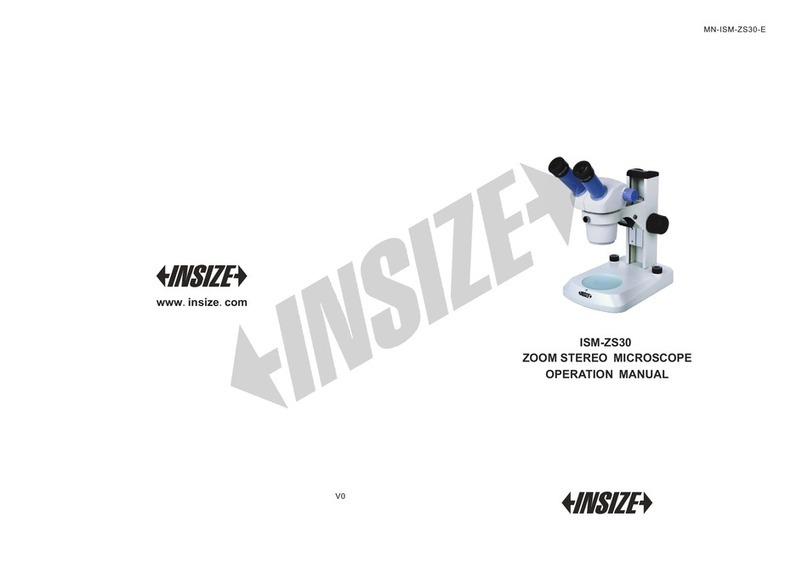
insize
insize ISM-ZS30 User manual
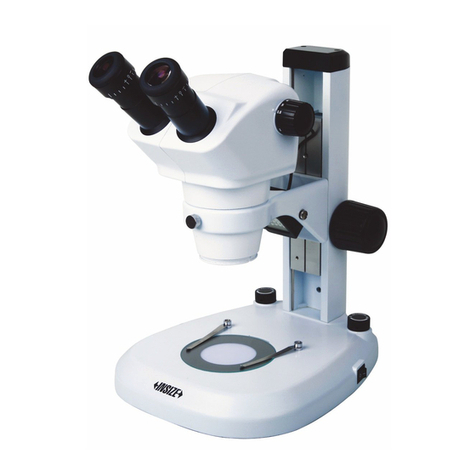
insize
insize ISM-ZS50 User manual

insize
insize ISM-DL120 User manual
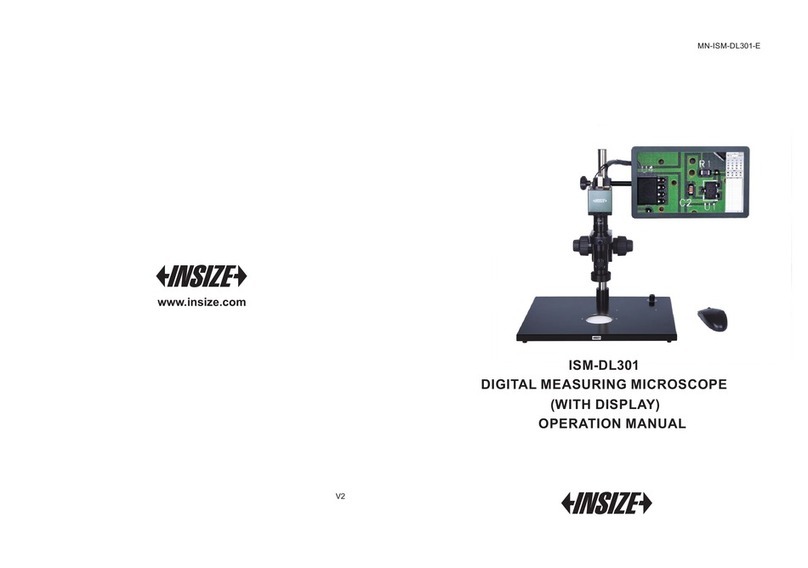
insize
insize ISM-DL301 User manual
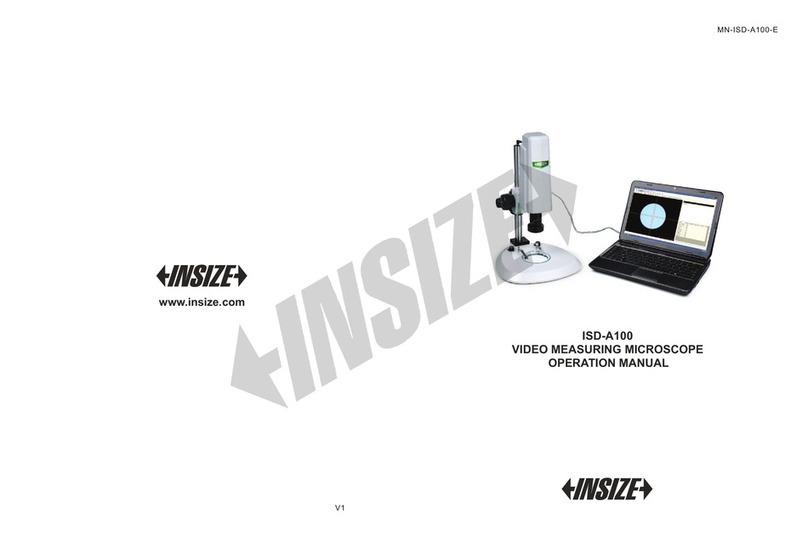
insize
insize ISD-A100 User manual
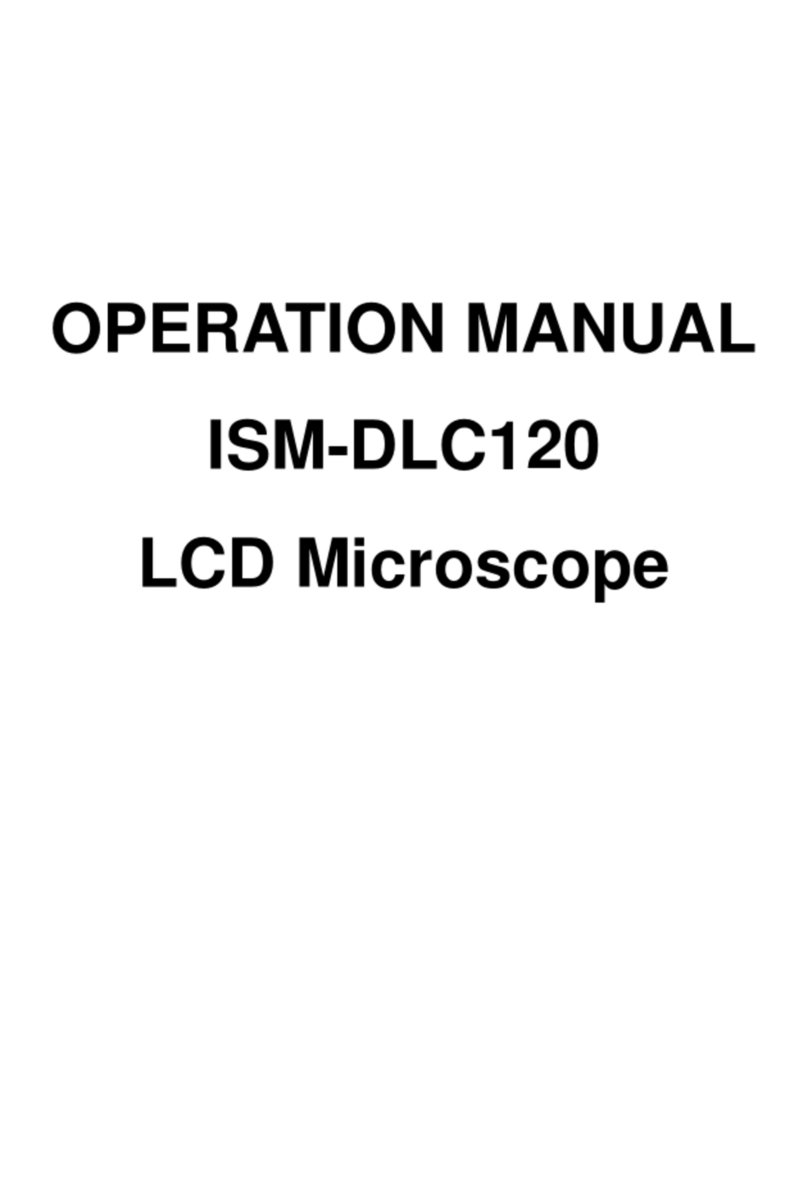
insize
insize ISM-DLC120 User manual
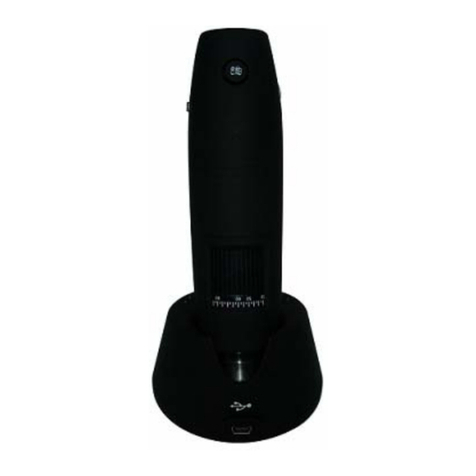
insize
insize ISM-WM200 User manual
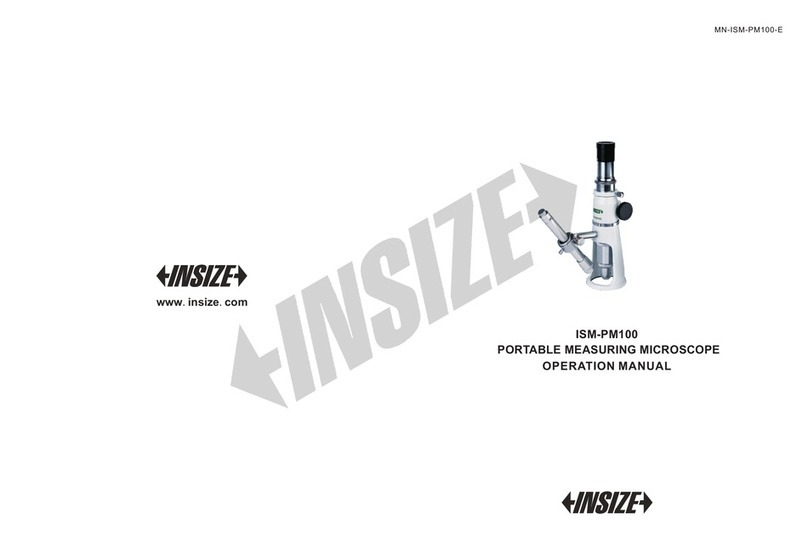
insize
insize ISM-PM100 User manual
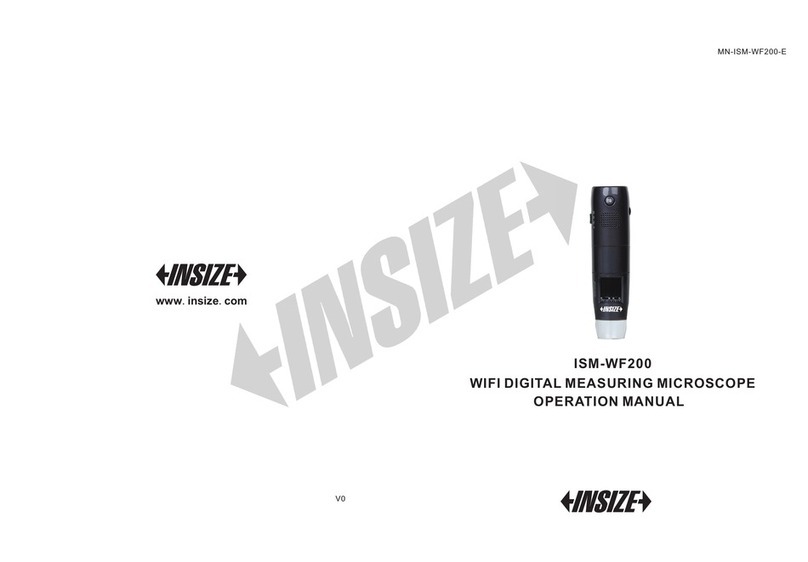
insize
insize ISM-WF200 User manual
Popular Microscope manuals by other brands
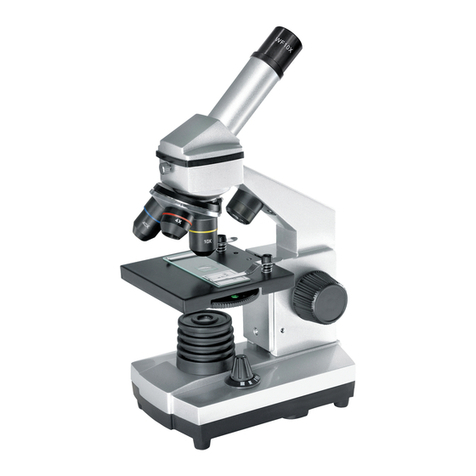
Bresser
Bresser MicroSet 40x-1024x operating instructions
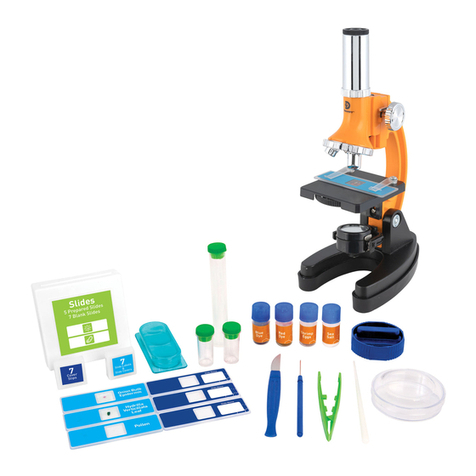
Discovery Telecom
Discovery Telecom 900x instruction manual
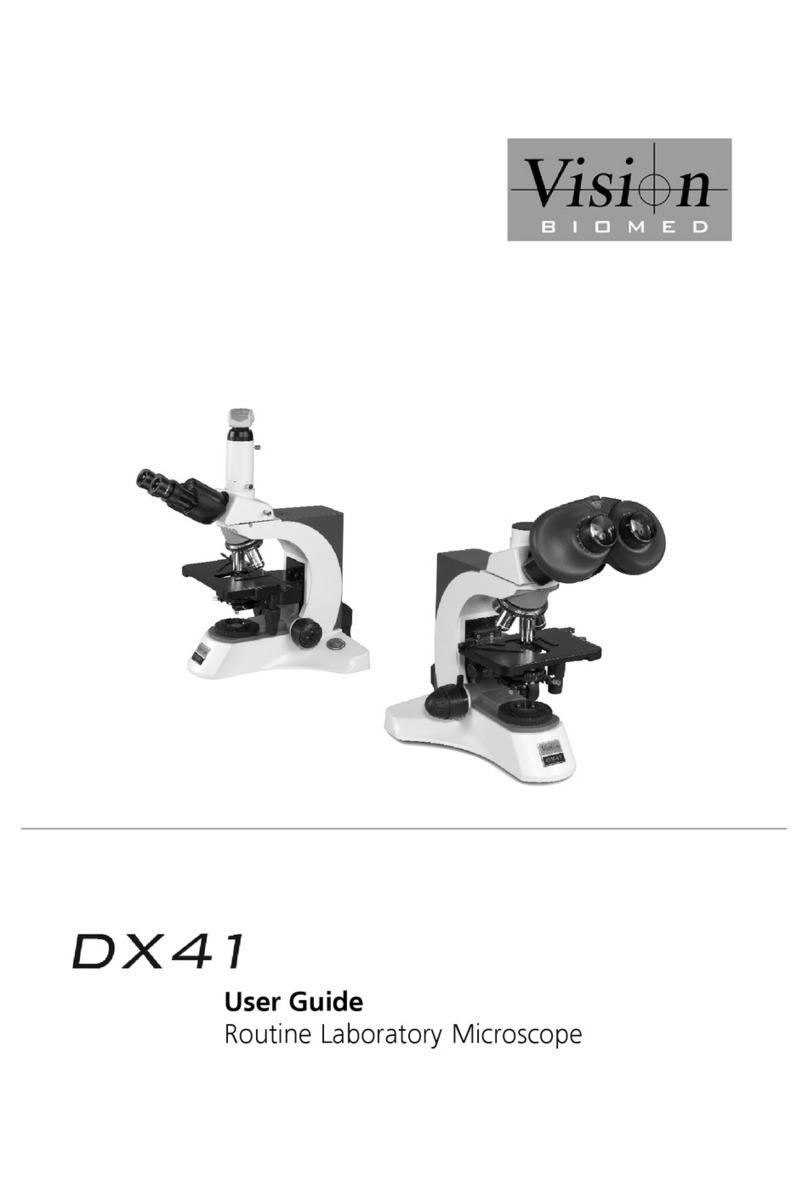
Vision Engineering
Vision Engineering DX41 user guide
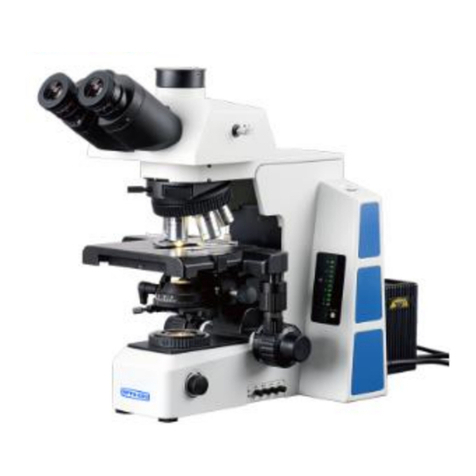
OPTO-EDU
OPTO-EDU A12.0910 instruction manual
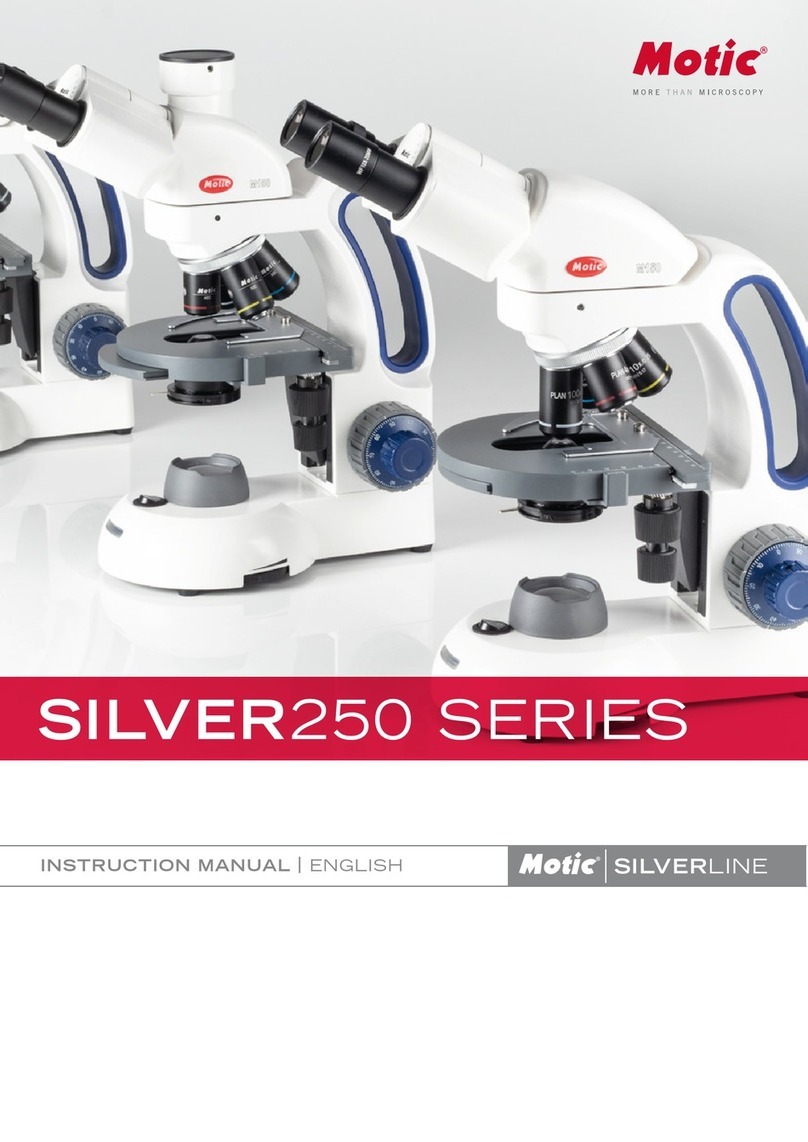
Motic
Motic SILVER250 Series instruction manual

Lumenera
Lumenera INFINITYHD quick start guide


